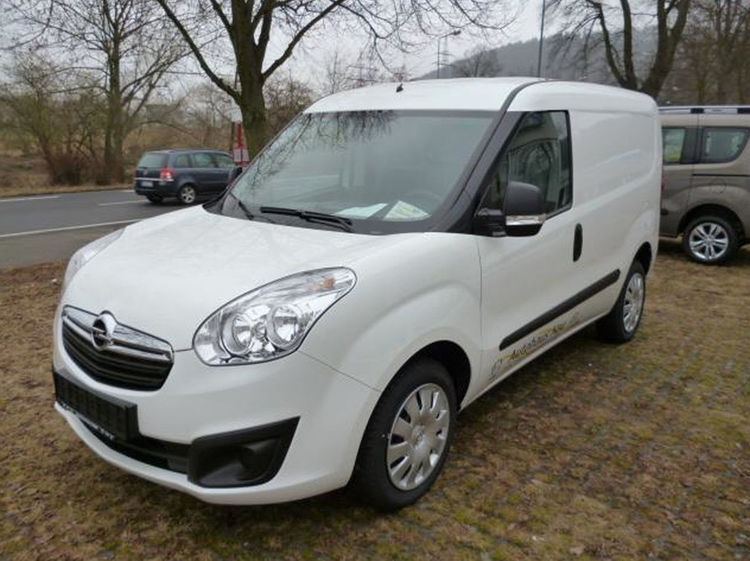Production 1993–present | ||
 | ||
Layout Front-engine, front-wheel drive | ||
The Opel Combo is a panel van and leisure activity vehicle from the German automaker Opel. The Combo first appeared in 1993, a second generation model was introduced in 2001, and the third has been manufactured from December 2011, based on the Fiat Doblò. The name "Combo" was previously applied as a suffix to a 3-door panel van body style of Opel Kadett E.
Contents
- Kadett Combo Combo A 19861993
- Combo B 19932001
- Names and markets
- Engines
- Combo C 20012011
- Combo D 2011present
- References
The Combo B and Combo C share platforms, vital components and some body panels with contemporary subcompact Opel Corsas, which used to be a typical pedigree for such a vehicle. The generations are denoted B and C in typical Opel fashion, but Holden applied the codes SB and XC respectively, reflecting the relation with SB and XC Holden Barinas (Opel Corsa B and C, respectively).
Kadett Combo (Combo A; 1986–1993)
The Opel Kadett Combo was introduced in January 1986, and finished production in August 1993. It was based on the Opel Kadett E small family car. It was built in the United Kingdom, at Ellesmere Port by Vauxhall until 1989. This was when production was transferred to Azambuja, Portugal, and built by Opel. In Germany, it was sold with a 1.3-litre petrol engine or a 1.6 (later 1.7) litre diesel unit.
In the United Kingdom the 3-door estate-based van was known as both the Bedford and (later) Vauxhall Astravan, and the high-roof van as the Astramax.
Combo B (1993–2001)
The first generation of Combo, launched in October 1993, was based on the Opel Corsa B, launched six months earlier. The front part (up to the B-pillar) is practically identical with the Corsa (except for the roof spoiler), but the platform (and thus wheelbase and the body in general) is extended to accommodate a tall, boxy cargo compartment, capable of carrying a Europallet. The Combo B had symmetrical twin rear doors that opened to the side (rather than a single tailgate). These are counted as a single "door" when referring to the body style as 3-door.
Following the increasing popularity of leisure activity vehicles, Opel launched a 5-passenger version of the Combo in 1995, called Opel Combo Tour. It differed from the panel van version by having the cargo section fitted with side windows and a three-passenger split-folding bench seat.
Although Combo's primary market is Europe, it has also been sold on other continents, in markets where GM traditionally use Opel-derived models. As the Azambuja Opel plant in Portugal is the sole production site of all Combos, all those models were replaced gradually with the Combo C in 2001. The Combo was also produced in relatively small numbers by SAIC subsidiary SAIC-Yizheng as the "Shanghai Auto (Shangqi) Saibao SAC6420", equipped with the same 1.6-litre engine and five-speed manual transmission as the Buick Sail.
Built from 2002 until 2005, there was also a DeLuxe version available, with alloy wheels and other extras.
Holden in Australia launched the SB series Combo in February 1996. It offered the 1.4-litre C14NZ engine, upgraded to C14SE specification in 1997. Sales continued until 2002, although the last SB Combos were built in 2001, but complianced as 2002 models.
Names and markets
Engines
Combo C (2001–2011)
The second generation was launched at the Frankfurt Motor Show, in September 2001. While most competitors severed their connections with their subcompact brethren, Opel decided to base the vehicle on the Corsa again. The use of subcompact Gamma platform constrained the overall width of the vehicle. While the general body shape was updated to fashionable "flush" look, the front part (up to the A-pillar) is shared with the Corsa. Compared to previous generation, the Combo C gained sliding rear side doors (versions with either single passenger side door or double doors are available).
An Opel Combo Tour version was also introduced, followed by Opel Combo Tour Tramp (Combo Tour Arizona in some markets), in an effort to attract leisure activity vehicle buyers. Combo Tour Tramp/Arizona was thought as a more off-road recreational vehicle. It features enhanced suspension tuning, increased ground clearance, chassis protection covers and numerous styling details that differentiate it from standard Combo Tours, with the intention to conjure a sturdy, outdoor-sports-related image. The Combo Tour was not offered by Vauxhall in the United Kingdom.
Commercial van versions retained the symmetrical twin rear doors, while the Tour versions have an option of a single tailgate (opening to the top). The tailgate is standard on Tour Tramp/Arizona. In December 2006, the Azambuja, Portugal factory closed down, and the production of the Opel Combo transferred to Zaragoza, Spain in 2007.
Holden in Australia launched the XC series Combo in September 2002. It offered the 1.6-litre Z16SE engine, upgraded to 1.4-litre Z14XEP specification in December 2004 for the MY05 update. Although production ended in late 2011, Holden in Australia and New Zealand stockpiled sufficient Combo inventory to last until mid-2013, with the final 2011-build vehicles complianced in early 2012. In August 2013, CarAdvice announced that the Holden Combo had been quietly discontinued, and will not be replaced by the Combo D, available to European customers.
Production of the Combo C ended in late 2011, in time for the December 2011 launch of the Combo D, which is based on the Fiat Doblò.
Names and markets
Engines
Combo D (2011–present)
The third generation has been manufactured from December 2011, and is based on the Fiat Doblò. The new Combo is manufactured in Turkey by Tofaş.
